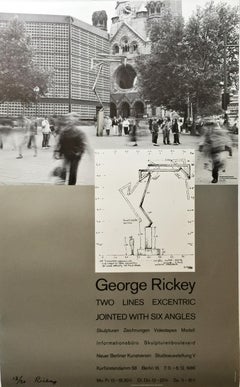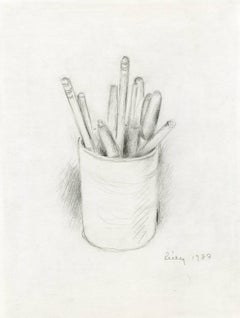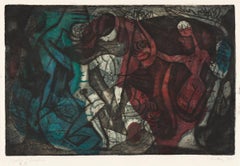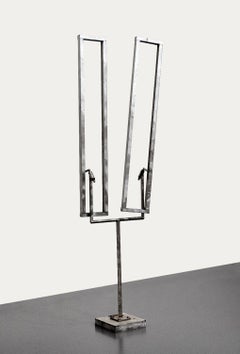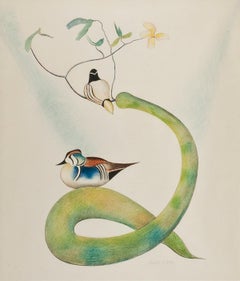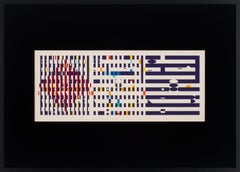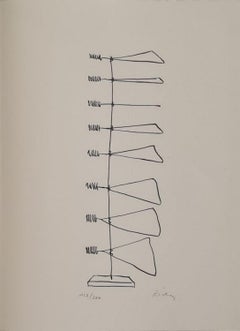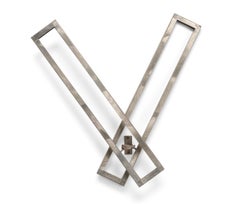George Rickey Art
American, 1907-2002
GEORGE RICKEY
Born: South Bend, Indiana, 1907 Died: St. Paul, Minnesota, 2002
George Rickey spent over five decades committed to the creation of poetic and precisely-calibrated sculptures that he referred to as his “useless machines.” Of all the natural forces, it was the wind’s movement that most captured Rickey’s imagination. He once wrote, “The artist finds waiting for him, as subject, not the trees, not the flowers, not the landscape, but the waving of branches and the trembling of stems, the piling up or scudding of clouds, the rising and setting and waxing and waning of heavenly bodies.”
Rickey began to devote himself to the investigation of motion in sculpture, producing dynamic works using simple geometric forms such as lines, squares, rectangles, circles, etc., in which his prodigious understanding of engineering and mechanics is demonstrable. Though the works enthusiastically collaborate with the interference of wind currents in their environment, the speed of their random movements are tempered by simple spacing and fixed arrangement of the elements. The relationship of the parts remains the same, but the dance is always changing. It is this tension that defines Rickey’s sculptures. “I think it’s important to make art that you have to wait for,” said the artist. As such, the works are able to oscillate gracefully through an infinite number of compositional iterations, engaging all aspects of the natural world around them—wind, light, rain, fog, or the lack thereof.
Much of Rickey’s work was created in his studio in East Chatham, New York, where he settled in 1960. Prior to that time, the artist had lived and taught in Bloomington, IN; New Orleans, LA; New York, NY, and throughout the Midwest. His childhood, youth and college years were spent in Scotland and Britain. Aside from East Chatham he had studios in Berlin, Germany and Santa Barbara, CA.
George Rickey's work is included in the permanent collections of over 150 museums worldwide, including the Hirshhorn Museum and Sculpture Garden, Smithsonian Institution, Washington, D.C.; Los Angeles County Museum of Art, California; Museum of Modern Art, New York; Metropolitan Museum of Art, New York; National Gallery of Art, Washington, D.C.; Walker Art Center, Minneapolis; National Gallery of Scotland, Edinburgh; Museum Boijmans Van Beuningen, Rotterdam and Kunstmuseum Bern, Switzerland, among many others. Key exhibitions include George Rickey: Monumental Sculptures on Park Avenue, New York (2021); A Life in Art: Works by George Rickey, Indianapolis Art Center, Indiana (2009); George Rickey: Kinetic Sculpture, A Retrospective, Vero Beach Museum of Art, Florida; Frederik Meijer Gardens and Sculpture Park, Grand Rapids and McNay Art Museum, San Antonio (2007-09); George Rickey: Kinetische Skulpturen, Museum für Kunst und Gewerbe, Hamburg, Germany (2003) and George Rickey – Retrospective Exhibition, Solomon R. Guggenheim Museum, New York (1979).(Biography provided by Karl Hutter Fine Art)
to
6
6
5
3
2
1
1
Two Lines Excentric Jointed with Six Angles, Offset lithograph signed/N 18/30
By George Rickey
Located in New York, NY
George Rickey
Large: 39 inches (vertical) x 24.5 inches (horizontal)
(Ships rolled in a tube measuring: 35 x 5)
Two Lines Excentric Jointed with Six Angles, 1986
Limited Edition Offs...
Category
1980s Kinetic George Rickey Art
Materials
Permanent Marker, Lithograph, Offset
Tetrahedron Variations (86, Verlag Marburg)
By George Rickey
Located in New York, NY
George Rickey
Tetrahedron Variations, 1971
Color Lithograph on Rives BFK Paper with Deckled Edges
Hand signed, numbered 52/100 and dated on front with publisher's and printer's blind...
Category
1970s Kinetic George Rickey Art
Materials
Lithograph
Sculptural Study
By George Rickey
Located in New York, NY
George Rickey
Sculptural Study, 1974
Lithograph on Rives BFK paper.
Signed in graphite on the lower front, with publishers' blind stamp. H.C.
11 1/2 × 5 3/4 inches
Unframed
Excellen...
Category
1970s Abstract Geometric George Rickey Art
Materials
Lithograph
Pencils and Pens
By George Rickey
Located in Fairlawn, OH
Pencils and Pens
Graphite on paper, 1987
Signed and dated by the artist lower right (see photo)
Condition: Excellent
Image/Sheet size: 13 5/16 x 10 11/16 inches
Rickey, a noted kine...
Category
1980s American Modern George Rickey Art
Materials
Graphite
Apollo and Daphne
By George Rickey
Located in New York, NY
A superb, richly-inked impression of this extremely scarce, early etching, aquatint and engraving with hand coloring in watercolor on cream wove paper. Colors are strong with crisp, ...
Category
1940s Kinetic George Rickey Art
Materials
Watercolor, Engraving, Etching, Aquatint
Two Open Rectangles Excentric
By George Rickey
Located in Greenwich, CT
Kinetic sculpture by George Rickey.
Incised with the artist's signature, date 1975 and number 1/3 (on the base).
Dimensions:
minimum: 79 by 21 ⅜ by 10 in.
maximum: 79 by 80 by 10 in...
Category
1970s Abstract George Rickey Art
Materials
Stainless Steel
Related Items
Two Wood Ducks on a Flowering Branch
By Joseph Stella
Located in New York, NY
Joseph Stella was a visionary artist who painted what he saw, an idiosyncratic and individual experience of his time and place. Stella arrived in New York in 1896, part of a wave of Italian immigrants from poverty-stricken Southern Italy. But Stella was not a child of poverty. His father was a notary and respected citizen in Muro Locano, a small town in the southern Appenines. The five Stella brothers were all properly educated in Naples. Stella’s older brother, Antonio, was the first of the family to come to America. Antonio Stella trained as a physician in Italy, and was a successful and respected doctor in the Italian community centered in Greenwich Village. He sponsored and supported his younger brother, Joseph, first sending him to medical school in New York, then to study pharmacology, and then sustaining him through the early days of his artistic career. Antonio Stella specialized in the treatment of tuberculosis and was active in social reform circles. His connections were instrumental in Joseph Stella’s early commissions for illustrations in reform journals.
Joseph Stella, from the beginning, was an outsider. He was of the Italian-American community, but did not share its overwhelming poverty and general lack of education. He went back to Italy on several occasions, but was no longer an Italian. His art incorporated many influences. At various times his work echoed the concerns and techniques of the so-called Ashcan School, of New York Dada, of Futurism and, of Cubism, among others. These are all legitimate influences, but Stella never totally committed himself to any group. He was a convivial, but ultimately solitary figure, with a lifelong mistrust of any authority external to his own personal mandate. He was in Europe during the time that Alfred Stieglitz established his 291 Gallery. When Stella returned he joined the international coterie of artists who gathered at the West Side apartment of the art patron Conrad Arensberg. It was here that Stella became close friends with Marcel Duchamp.
Stella was nineteen when he arrived in America and studied in the early years of the century at the Art Students League, and with William Merritt Chase, under whose tutelage he received rigorous training as a draftsman. His love of line, and his mastery of its techniques, is apparent early in his career in the illustrations he made for various social reform journals. Stella, whose later work as a colorist is breathtakingly lush, never felt obliged to choose between line and color. He drew throughout his career, and unlike other modernists, whose work evolved inexorably to more and more abstract form, Stella freely reverted to earlier realist modes of representation whenever it suited him. This was because, in fact, his “realist” work was not “true to nature,” but true to Stella’s own unique interpretation.
Stella began to draw flowers, vegetables, butterflies, and birds in 1919, after he had finished the Brooklyn Bridge series of paintings, which are probably his best-known works. These drawings of flora and fauna were initially coincidental with his fantastical, nostalgic and spiritual vision of his native Italy which he called Tree of My Life (Mr. and Mrs. Barney A. Ebsworth Foundation and Windsor, Inc., St. Louis, illus. in Barbara Haskell, Joseph Stella, exh. cat. [New York: Whitney Museum of American Art, 1994], p. 111 no. 133).
Two Wood Ducks...
Category
20th Century American Modern George Rickey Art
Materials
Color Pencil
“Three Movements" Limited Edition Hand-Signed Serigraph by Yaacov Agam, Framed
By Yaacov Agam
Located in Encino, CA
"Three Movements," an original silkscreen by Yaacov Agam, is a piece for the true collector. Agam is considered the father of Kinetic art. His iconic style is recognizable across the...
Category
1970s Kinetic George Rickey Art
Materials
Screen
No Reserve
H 30.125 in W 41.875 in D 1.25 in
Jean Miotte - Abstract Composition - Original Signed Lithograph
By Jean Miotte
Located in Collonge Bellerive, Geneve, CH
Jean Miotte - Rare Original Signed Lithograph
Title: Abstract Composition
Dimensions: 76 x 56 cm
Edition: 64/99
Signed and Numbered in pencil
Jean Miotte, 1926 - 2016
Miotte came o...
Category
1990s Abstract Expressionist George Rickey Art
Materials
Aquatint
H 29.93 in W 22.05 in D 0.04 in
Zao Wou-ki - Moments - Original Aquatint with Hand-Signed Justification
By Zao Wou-Ki
Located in Collonge Bellerive, Geneve, CH
Zao Wou-ki - Moments - Original Aquatint
Edition of 130
Dimensions: 34.2 x 30.5 cm
Vellum paper BFK Rives
1996
Bibliography: Jørgen Ågerup, Zao Wou-Ki: The Graphic Work, A Catalogue ...
Category
1990s Abstract Expressionist George Rickey Art
Materials
Aquatint
H 13.47 in W 12.01 in D 0.04 in
LEBEN - Asymmetrical organic standing sculpture
By ENNAIA
Located in Weslaco, TX
Life is often perceived as linear, a flat process with no return. Leben contradicts this belief and exposes the countless deviations that the path could take. This piece represents l...
Category
2010s Abstract George Rickey Art
Materials
Steel, Stainless Steel
Bruno Munari (1907 – 1998 ) – hand-signed serigraphy – 1983
By Bruno Munari
Located in Varese, IT
Serigraphy on Fabriano paper, edited in 1983
limited edition, numbered in lower left corner as pda ( artist proof )
signed in pencil by artist
paper size: 68 x 68 cm
excellent condit...
Category
1980s Abstract Geometric George Rickey Art
Materials
Paper, Lithograph, Screen
Hot Pink Comp - kinetic wall sculpture
By Jose Margulis
Located in New York, NY
I digitally design 3-D objects and compositions, and cut them in slices from different types of plastic sheet materials. These slices are then fixed to a rigid canvas, a pedestal or ...
Category
21st Century and Contemporary Kinetic George Rickey Art
Materials
Lucite
Vintage Pop Art 1997 Offset Lithograph Larry Rivers Music Poster Hamptons NY
By Larry Rivers
Located in Surfside, FL
Larry Rivers
"The Music Festival of the Hamptons / July 18-27 1997" poster,
Not hand signed. [Dimensions: 24" H x 18" W]
Larry Rivers (born Yitzroch Loiza Grossberg) (1923 – 2002) was an American artist, musician, filmmaker, and occasional actor. Considered by many scholars to be the "Godfather" and "Grandfather" of Pop art, he was one of the first artists to merge non-objective, non-narrative art with narrative and objective abstraction.
Rivers took up painting in 1945 and studied at the Hans Hofmann School from 1947–48. He earned a BA in art education from New York University in 1951.
His work was quickly acquired by the Museum of Modern Art. A 1953 painting Washington Crossing the Delaware was damaged in fire at the museum five years later.
He was a pop artist of the New York School, reproducing everyday objects of American popular culture as art. He was one of eleven New York artists featured in the opening exhibition at the Terrain Gallery in 1955 along with Paul Mommer, Leonard Baskin, Peter Grippe
During the early 1960s Rivers lived in the Hotel Chelsea, notable for its artistic residents such as Bob Dylan, Janis Joplin, Leonard Cohen, Arthur C. Clarke, Dylan Thomas, Sid Vicious and multiple people associated with Andy Warhol Factory and where he brought several of his French nouveau réalistes friends like Yves Klein who wrote there in April 1961 his Manifeste de l'hôtel Chelsea, Arman, Martial Raysse, Jean Tinguely, Niki de Saint-Phalle, Christo & Jean Claude, Daniel Spoerri or Alain Jacquet, several of whom, like Rivers, left some pieces of art in the lobby of the hotel for payment of their rooms. In 1965, Rivers had his first comprehensive retrospective in five important American museums.
His final work for the exhibition was The History of the Russian Revolution, which was later on extended permanent display at the Hirshhorn Museum and Sculpture Garden in Washington, DC. He spent 1967 in London collaborating with the American painter Howard Kanovitz.
In 1968, Rivers traveled to Africa for a second time with Pierre Dominique Gaisseau to finish their documentary Africa and I, which was a part of the groundbreaking NBC series Experiments in Television. During this trip they narrowly escaped execution as suspected mercenaries.
During the 1970s, Rivers worked closely with Diana Molinari and Michel Auder on many video tape projects, including the infamous Tits, and also worked in neon.
Rivers's legs appeared in John Lennon and Yoko Ono's 1971 film Up Your Legs Forever.
From 1940–1945 he worked as a jazz saxophonist in New York City, changing his name to Larry Rivers in 1940 after being introduced as "Larry Rivers and the Mudcats" at a local pub. He studied at the Juilliard School of Music in 1945–46, along with Miles Davis, with whom he remained friends until Davis's death in 1991.
Larry Rivers was born in the Bronx to Samuel and Sonya Grossberg, Jewish immigrants from Ukraine. In 1945, he married Augusta Berger, and they had one son, Steven. Rivers also adopted Berger's son from a previous relationship, Joseph, and reared both children after the couple divorced. In 1949 he had his first one-man exhibition at the Jane Street Gallery in New York. This same year, he met and became friends with John Ashbery, and Kenneth Koch. In 1950 he met Frank O’Hara. This same year he took his first trip to Europe spending eight months in Paris, France, reading and writing poetry. Beginning in 1950 and continuing until Frank’s death in July of 1966, Larry Rivers and Frank O’Hara cultivated a uniquely creative friendship that produced numerous collaborations, as well as inspired paintings and poems. In 1951 Rivers’ works were shown at the Tibor de Nagy Gallery where he continued to show annually (except 1955) for about 10 years. In 1954 he had his first exhibition of sculptures at the Stable Gallery, New York. In 1955 The Museum of Modern Art acquired Washington Crossing the Delaware. This same year he won 3rd prize in the Corcoran Gallery national painting competition for “Self-Figure.” Rivers’ also painted “Double Portrait of Berdie” in 1955, which was soon purchased by the Whitney Museum.
In 1957 he and Frank O’Hara began work on “Stones,” a collaborative mix of images and poetry in a series of lithograph for Tatyana Grosman company ULAE. During this time he also appeared on the television game show “The $64,000.00 Question” where along with another contestant, they both won, each receiving $32,000.00. In 1958 he again spent time in Paris and played in various jazz bands. In 1959 he painted Cedar Bar Menu...
Category
1990s Pop Art George Rickey Art
Materials
Lithograph, Offset
Alexander Calder lithograph (derrière le miroir)
By Alexander Calder
Located in NEW YORK, NY
Alexander Calder Lithograph c. 1967 from Derrière le miroir:
Lithograph in colors; 15 x 11 inches.
Very good overall vintage condition; well-preseved.
Unsigned from an edition of u...
Category
1960s Abstract George Rickey Art
Materials
Lithograph, Offset
Untitled (Still Life, Interior)
By Harold Haydon
Located in Chicago, IL
A detailed ink on paper drawing of a still-life in an interior by artist Harold Haydon.
Harold Emerson Haydon was born in Fort William, Ontario, Canada in 1909. Haydon came to Chi...
Category
1950s American Modern George Rickey Art
Materials
Paper, Ink
Nordex
By Victor Vasarely
Located in Miami, FL
Victor Vasarely
"Nordex" 1985
Lithograph
Editions Denise Rene.
Ed of 200
31 x 31 in
Signed and numbered with publisher blind stamp.
Framed and ready to hang.
Category
1980s Kinetic George Rickey Art
Materials
Lithograph
Midi
By Auguste Herbin
Located in Miami, FL
Vendredi - Plate 3 from the 12 plate Portfolio, 1959
Published by Denise Rene, Paris
Lithograph in colors on heavy paper
20 x 26 inches
Signed, dated and numbered in ink, edition of ...
Category
1950s Abstract Geometric George Rickey Art
Materials
Lithograph
Previously Available Items
Erker-Treffen 2
By George Rickey
Located in Paris, FR
Lithograph, 1974
Handsigned by the artist in pencil and numbered 152/200
Publisher : Erker (St. Gallen)
LCD4751
Category
1970s Abstract George Rickey Art
Materials
Lithograph
Two Open Rectangles Up Wall, Mounted
By George Rickey
Located in Greenwich, CT
The international master in kinetic sculpture, George Ricky was a master of balance and movement in stainless steel outdoor and indoor sculptures. He was contemporary artist who is ...
Category
1980s Kinetic George Rickey Art
Materials
Stainless Steel
George Rickey "Parallelepiped" Sculpture
By George Rickey
Located in West Palm Beach, FL
George Rickey kinetic sculpture
signed and dated, edition of three.
3/3.
Category
1980s American Vintage George Rickey Art
Materials
Steel
Oblique Column of Open Squares
By George Rickey
Located in Palm Desert, CA
A kinetic, stainless steel sculpture by George Rickey. Edition 2/3. Signed center of base, "Rickey 1981". Edition left center of base, "2/3".
Provenance:
GE Corporate Art Collect...
Category
1980s Contemporary George Rickey Art
Materials
Stainless Steel
George Rickey "Two Lines Leaning" Sculpture
By George Rickey
Located in West Palm Beach, FL
An elegant variation of George Rickeys' Kinetic work.
Numbered, signed and dated.
George Rickey 1/3, 1984.
This sculpture has great movement.
Stainless steel.
Category
1980s American Vintage George Rickey Art
George Rickey Sculpture "Double Spirals"
By George Rickey
Located in West Palm Beach, FL
Gold Plated Stainless Steel Wire sculpture
1972
An early example by the master of kinetic movement.
Category
1970s American Vintage George Rickey Art
Materials
Wood
George Rickey art for sale on 1stDibs.
Find a wide variety of authentic George Rickey art available for sale on 1stDibs. You can also browse by medium to find art by George Rickey in lithograph, aquatint, engraving and more. Much of the original work by this artist or collective was created during the 20th century and is mostly associated with the abstract style. Not every interior allows for large George Rickey art, so small editions measuring 6 inches across are available. Customers who are interested in this artist might also find the work of Jack Sonenberg, Vincent Longo, and Ray Elman. George Rickey art prices can differ depending upon medium, time period and other attributes. On 1stDibs, the price for these items starts at $1,500 and tops out at $32,000, while the average work can sell for $3,750.
